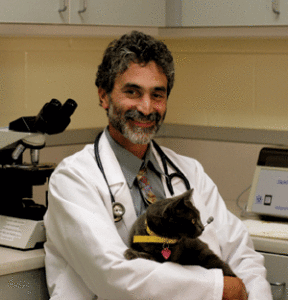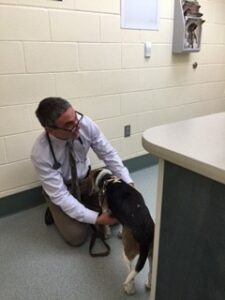-
Adopt
-
Veterinary Care
Services
Client Information
- What to Expect – Angell Boston
- Client Rights and Responsibilities
- Payments / Financial Assistance
- Pharmacy
- Client Policies
- Our Doctors
- Grief Support / Counseling
- Directions and Parking
- Helpful “How-to” Pet Care
Online Payments
Referrals
- Referral Forms/Contact
- Direct Connect
- Referring Veterinarian Portal
- Clinical Articles
- Partners in Care Newsletter
CE, Internships & Alumni Info
CE Seminar Schedule
Emergency: Boston
Emergency: Waltham
Poison Control Hotline
-
Programs & Resources
- Careers
-
Donate Now
 by Doug Brum, DVM
by Doug Brum, DVM
www.angell.org/internalmedicine
internalmedicine@angell.org
617-541-5186
Canine Cushing’s disease remains one of the most common endocrine disorders veterinarians diagnose, with pituitary dependent disease responsible for almost 90% of cases. Historically, Lysodren has been the hallmark of treatment. In 1999, Trilostane, a new treatment option, became FDA approved. Since that time, we have been using it as our usual first line of therapy for pituitary dependent disease.
Unlike Lysodren, which is a cytotoxic drug, Trilostane works as an enzyme blocker by inhibiting the production of cortisol at the level of the adrenal gland. Specifically, trilostane competitively inhibits 3 Beta-hydroxysteroid dehydrogenase, which is the enzyme responsible for converting pregnenolone to progesterone in the adrenal cortex. This leads to a decrease in production of cortisol as well as, to a lesser extent, aldosterone and sex hormones. Over 85% of dogs show clinical improvement with therapy. Survival times of dogs treated with trilostane or Lysodren are similar (about 600-900 days).
When we first started using Trilostane, a much larger dose was used. Commonly we would start dogs on 4-10mg/kg SID. As experience with the drug grew, it became evident that this dose was too high for many dogs. Recent studies (Feldman, JAVMA 2011) showed low dose BID therapy to be as or more effective and safer than higher dose SID therapy. Twice daily administration rather than once-a-day therapy seems to make more sense as the drug probably loses its effectiveness after 8-10 hours. This is especially important if a dog also has diabetes, as only controlling cortisol secretions for part of the day would make diabetic regulation quite difficult. We now will start dogs on about 1-2mg/kg of Trilostane BID.The drug should be given with a meal to optimize absorption.
Dogs will need to have an ACTH stimulation test and electrolytes checked about 7-14 days after starting trilostane. ACTH stimulation tests should be taken about 3-6 hours post pill. Additionally, I always check electrolytes when a dog is on Trilostane. Ideal stimulation results are cortisols under 5.5 mcg/dl at the 1-hour post sample, but one must take into account how the dog is doing clinically and correlate this with these results. For example, if a dog’s 1-hour post stimulation is 10 mcg/dl, but his clinical signs have resolved or are improving significantly, we would typically leave him at the same dose, even though the level is elevated. Delayed effect of the drug is also common, especially in the first few weeks. Cortisol levels will be significantly lower in some dogs tested again several weeks later even without having had a change in dose. As another example, after 2 weeks of treatment, if the dog’s cortisol levels are slightly elevated but his signs are still present, I would hesitate to increase the dose, as the dog’s clinical signs may improve within a few weeks. In these cases, a recheck ACTH stimulation should be considered several weeks later.
These delays in response are why it is critical to correlate clinical signs and test results before deciding on medication adjustments. A final example would be a dog that is clinically normal, but has a post cortisol concentration of under 2mcg/dl. Some would continue the same dose because the dog’s clinical signs are now normal. I would be inclined to decrease the dose slightly; as again, the cortisol levels can still drop with time. These dogs should be followed closely.
It is extremely common for serum potassium levels to be elevated when using Trilostane. In fact, you should expect mild to moderate elevations. Given its mechanism of action, this should not be surprising. Trilostane should be used with caution with anti-aldosterone drugs (e.g. ACE inhibitors, spironolactone). Occasionally, one will need to change to a different medication if the potassium rises too high.
The main advantage of Trilostane over Lysodren is that there is no loading phase, and many feel it is safer and easier to use. Still, dogs need to be monitored closely as side effects can occur. The main side effects of the medication correlate with decreased adrenal function and are usually gastrointestinal. Hypoadrenocorticism can occur that may or may not be reversible. Acute adrenal necrosis can occur, that can be life threatening if not treated quickly. This is an idiosyncratic reaction, but fortunately a very rare occurrence. Using the lower low dose BID therapy decreases the chance of severe side effects.
For more information about Trilostane or Angell’s Internal Medicine service, please call 617 541-5186 or e-mail internalmedicine@angell.org. You can also reach Dr. Brum at dbrum@angell.org.